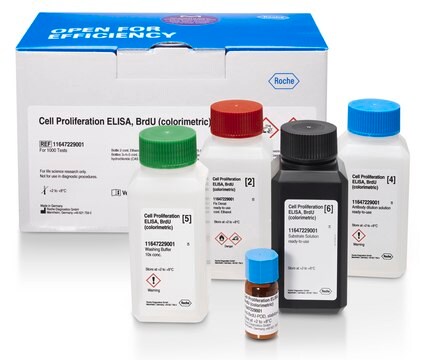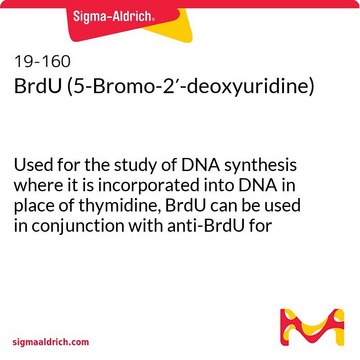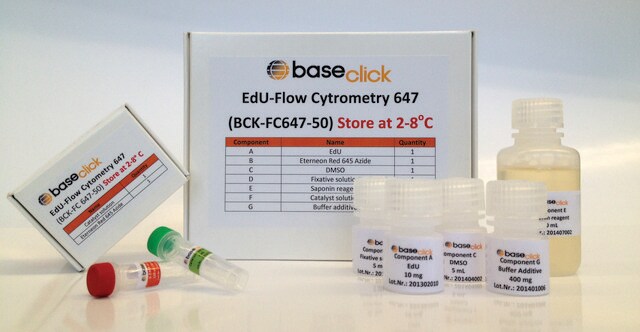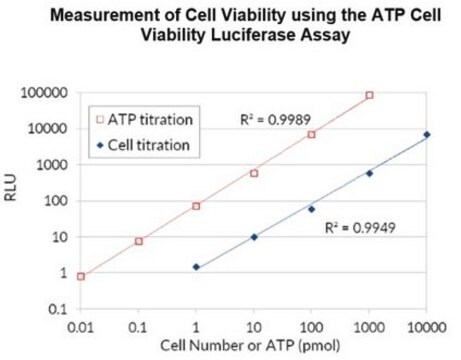おすすめの製品
詳細
細胞DNAに取り込まれた5-ブロモ-2'-デオキシ-ウリジン(BrdU)の検出のための免疫組織化学アッセイです。
細胞の増殖は、細胞DNAへの放射性同位体[3H]-チミジンの取り込みを、オートラジオグラフィーによってモニタリングすることで調査できます。
あるいは、5-ブロモ-2'-デオキシ-ウリジン(BrdU)が、チミジンの代わりに使用できます。DNAにBrdUを取り込んだ細胞は、BrdUに対するモノクローナル抗体と、酵素または蛍光試薬で標識した二次抗体を使用することで容易に検出できます。
あるいは、5-ブロモ-2'-デオキシ-ウリジン(BrdU)が、チミジンの代わりに使用できます。DNAにBrdUを取り込んだ細胞は、BrdUに対するモノクローナル抗体と、酵素または蛍光試薬で標識した二次抗体を使用することで容易に検出できます。
特異性
抗-BrdUモノクローナル抗体は、5-ブロモ-2'-デオキシ-ウリジンに特異的に結合し、5-ヨード-2'-デオキシ-ウリジンと交叉反応を示します(10%)。抗-BrdUは、5-フルオロ-2'-デオキシ-ウリジンならびにチミジンおよびウリジンなどの他の内因性細胞成分と交叉反応を示しません。
アプリケーション
5-ブロモ-2′-デオキシ-ウリジン標識・検出キットIIは、次の用途で使用されています。
- 組織学的検査のため歯根の標識を行う。
- マウス前頭切片の免疫染色。
- 肝細胞癌切片の免疫蛍光イメージング。
本キットは、細胞DNAに取り込まれたBrdUの免疫組織化学検出に使用されます。
特徴および利点
- 安全:放射性同位体は使用していません。
- 容易に実施:標準的な免疫組織化学プロトコールに従います。
- 高感度:ヌクレアーゼとのDNAの変性により、BrdUの高感度検出が可能。
- 柔軟:二重標識プロトコールも可能。
包装
7種のコンポーネントを含む1キット。
原理
BrdUでプレ標識したサンプルをエタノールと混合し、その後、最適化されたヌクレアーゼ混合物を含む抗BrdUモノクローナル抗体とインキュベートします。これらのヌクレアーゼは、抗体がBrdUに結合できるように一重鎖DNA断片を生成します。次に、アルカリ性ホスファターゼ(AP)で標識化した、マウスイムノグロブリンに対する抗体を加え、抗BrdU抗体と結合させます。サンプルを、その後、AP基質およびNBT/BCIPとインキュベートすると、NBT/BCIPは代謝されて発色性の反応物が生成されます。サンプルを位相差顕微鏡を使用して測定します。
調製ノート
使用濃度:標識試薬の使用濃度は、In Situ細胞増殖キットのWCに対応します。
サンプル物質:
細胞培養:接着細胞、懸濁細胞、組織または外植片培養。凍結またはパラフィン包埋組織切片(in vivo標識後)。
サンプル物質:
細胞培養:接着細胞、懸濁細胞、組織または外植片培養。凍結またはパラフィン包埋組織切片(in vivo標識後)。
その他情報
ライフサイエンス研究のみに使用できます。診断用には使用できません。
キットの構成要素のみ
製品番号
詳細
- BrdU Labeling Reagent 1,000x concentrated
- Washing Buffer concentrate 10x concentrated
- Incubation Buffer
- Anti-BrdU antibody, contains nucleases for DNA denaturation
- Anti-mouse Ig-alkaline Phosphatase antibody
- NBT
- BCIP
シグナルワード
Danger
危険有害性の分類
Acute Tox. 4 - Acute Tox. 4 Inhalation - Eye Irrit. 2 - Flam. Liq. 3 Dermal - Muta. 1B - Repr. 1B - Skin Sens. 1
保管分類コード
3 - Flammable liquids
WGK
WGK 2
引火点(°F)
136.4 °F
引火点(℃)
58 °C
試験成績書(COA)
製品のロット番号・バッチ番号を入力して、試験成績書(COA) を検索できます。ロット番号・バッチ番号は、製品ラベルに「Lot」または「Batch」に続いて記載されています。
この製品を見ている人はこちらもチェック
A Lecointe et al.
Cytotechnology, 65(5), 705-724 (2013-06-13)
Cell cultures from reef-building scleractinian corals are being developed to study the response of these ecologically important organisms to environmental stress and diseases. Despite the importance of cell division to support propagation, cell proliferation in polyps and in vitro is
Pten regulates neural crest proliferation and differentiation during mouse craniofacial development
Yang T, et al.
Developmental Dynamics, 247(2), 304-314 (2018)
CXCL14 and MCP1 are potent trophic factors associated with cell migration and angiogenesis leading to higher regenerative potential of dental pulp side population cells
Hayashi Y, et al.
Stem Cell Research & Therapy, 6(1), 111-111 (2015)
L J Backman et al.
Scandinavian journal of medicine & science in sports, 23(6), 687-696 (2012-02-02)
The histopathology of tendons with painful tendinopathy is often tendinosis, a fibrosis-like condition of unclear pathogenesis characterized by tissue changes including hypercellularity. The primary tendon cells (tenocytes) have been shown to express adrenoreceptors (mainly alpha-2A) as well as markers of
Hitoshi Ikeda et al.
Journal of lipid research, 50(3), 556-564 (2008-10-29)
Sphingosine 1-phosphate (S1P), a bioactive lipid mediator, stimulates proliferation and contractility in hepatic stellate cells, the principal matrix-producing cells in the liver, and inhibits proliferation via S1P receptor 2 (S1P(2)) in hepatocytes in rats in vitro. A potential role of
資料
Cell based assays for cell proliferation (BrdU, MTT, WST1), cell viability and cytotoxicity experiments for applications in cancer, neuroscience and stem cell research.
Cell based assays for cell proliferation (BrdU, MTT, WST1), cell viability and cytotoxicity experiments for applications in cancer, neuroscience and stem cell research.
ライフサイエンス、有機合成、材料科学、クロマトグラフィー、分析など、あらゆる分野の研究に経験のあるメンバーがおります。.
製品に関するお問い合わせはこちら(テクニカルサービス)














